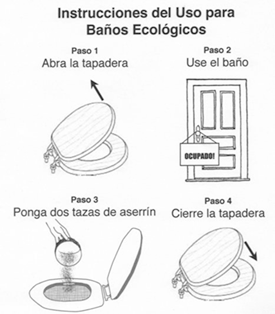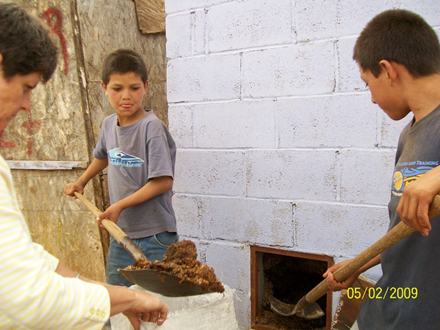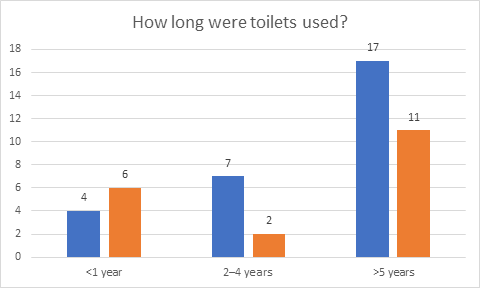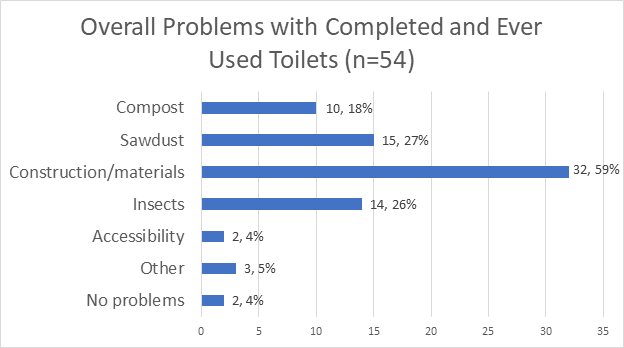Composting Toilets - Details
How does it work?
 Composting toilets are closed systems that enable the conversion of human excreta to a harmless and nutrient-rich soil enhancement while keeping that waste separate from the outside environment during the process. Composting toilets ensure that the environment within the system supports the survival and growth of microorganisms, such as aerobic bacteria and fungi, that carry out the work of the system. These microorganisms require oxygen as they consume the human waste and produce the final product, also known as humus. Because human waste is high in nitrogen, they also require an added source of carbon, usually plant material such as sawdust or leaves. If their environment becomes too wet, beneficial microorganisms are unable to survive and are outcompeted by anaerobic bacteria, many of which are harmful to humans.
Composting toilets are closed systems that enable the conversion of human excreta to a harmless and nutrient-rich soil enhancement while keeping that waste separate from the outside environment during the process. Composting toilets ensure that the environment within the system supports the survival and growth of microorganisms, such as aerobic bacteria and fungi, that carry out the work of the system. These microorganisms require oxygen as they consume the human waste and produce the final product, also known as humus. Because human waste is high in nitrogen, they also require an added source of carbon, usually plant material such as sawdust or leaves. If their environment becomes too wet, beneficial microorganisms are unable to survive and are outcompeted by anaerobic bacteria, many of which are harmful to humans.
The principal components of any composting toilet are:
- A composting reactor connected to one or more dry toilets;
- A screened exhaust system to remove odors, carbon dioxide, water vapor, and the by-products of aerobic decomposition (can include a fan in areas where air does not circulate well);
- A means of ventilation to provide oxygen for the aerobic organisms in the composter;
- A means of managing excess liquid and leachate; and
- An access door for removal of the end-product.
The Nogales Double Chamber Composting Toilet
There are multiple composting toilet designs available. The model described here was designed to function well in the hot and dry climate of the Arizona-Sonora border region. In addition, the materials and skills needed to construct this composting toilet system are readily available in the region.
The features of the Nogales Double Chamber Composting Toilet are:
- Has two chambers, one in use and the other within which the aerobic process of decomposition takes place, plus four walls and the roof.
- The back side of the facility from which the compost is drawn out oriented toward the sun whenever possible. [show diagrams nearby]
- One chamber made of cinderblock 44 in. deep x 80 in. wide x 27 in. high, divided to create two sections, open at the bottom and with a cement slab placed on top to serve as the toilet seat. The chamber structure functions as the foundation for the walls that can be made of cinderblock or fibrous concrete blocks.
- Has a 4 in. PVC pipe running from inside the chambers to the outside to promote ventilation.
- Has two deposit chambers, each with a 20 by 24 in. back door to be used in taking out the compost.
- Has a gasketed toilet seat and lid.
- Has a screen placed over the ventilation opening.
- Cracks and openings should be carefully sealed.
The toilets can be located next to a house with access from the inside or outside and either connected to or separated from the main house.

The Nogales, Sonora composting toilet project was guided by an Advisory Board which established criteria for selection of the project participants. These criteria included:
- The family has no bathroom or is using a pit hole.
- There is sufficient space for a bathroom.
- The site is ready.
- The family has the resources (materials or cash) to contribute toward the cost of the bathroom, or someone in the family can help with the construction so the families invest in the project from the beginning.
- Households with more residents will be given preference as more people will benefit from the toilet.
- The household members own their land; the house is not being rented.
How do you use a composting toilet?
 The double-chamber design was selected for its ease of use. The toilet is constructed to be at the same height as a flush toilet, and the two chambers allow for one side to be in use while the material in the other side is being composted [photo]. After every use of the toilet, a handful of sawdust is sprinkled on the deposit to allow aeration between layers of waste and provide carbon to the microorganisms. Once the process is complete, the composting toilet must be closed tightly so no insects get inside and so the composting process can occur properly and efficiently. The vents, covered with screens, ensure that air circulates through the toilet while keeping out insects. When the toilet chamber is full, the lid should be carefully closed and sealed. The material inside should remain for at least 4 months (longer in colder temperatures) to ensure that it is fully decomposed and safe to remove. The compost is removed through the rear doors.
The double-chamber design was selected for its ease of use. The toilet is constructed to be at the same height as a flush toilet, and the two chambers allow for one side to be in use while the material in the other side is being composted [photo]. After every use of the toilet, a handful of sawdust is sprinkled on the deposit to allow aeration between layers of waste and provide carbon to the microorganisms. Once the process is complete, the composting toilet must be closed tightly so no insects get inside and so the composting process can occur properly and efficiently. The vents, covered with screens, ensure that air circulates through the toilet while keeping out insects. When the toilet chamber is full, the lid should be carefully closed and sealed. The material inside should remain for at least 4 months (longer in colder temperatures) to ensure that it is fully decomposed and safe to remove. The compost is removed through the rear doors.
What can the compost be used for?
Like any compost, the compost from a composting toilet is rich in nutrients and an important addition to soil, especially the sandy loam often found in arid regions. To protect against possible contamination from human waste that was not fully composted, we recommend that the compost be used on trees and plants where it will not come in contact with any roots, fruits, or leaves that will be eaten by humans.
Have people in Nogales been satisfied with their toilets?
Researchers from the University of Arizona Bureau of Applied Research in Anthropology (BARA) worked with high school and college students from Nogales, Sonora to monitor and evaluate the composting toilets constructed in Colonia Colinas del Sol. Thirty toilets were completed and monitored between 2008 and 2009. Monitoring involved visual inspection of the bathrooms and toilets, recording information about the physical condition of the tanks, walls, roof, and door as well as the presence of insects, sawdust, and toilet paper and whether the toilet lid was open or closed when they arrived. The monitors also interviewed the household resident responsible for maintaining the toilet and asked questions about the use and maintenance of the toilet, the residents’ satisfaction with the toilet, and any problems with the toilet. In an effort to understand whether and how information about the toilets was being spread, monitors also asked residents whether they had shown the toilet to anyone else during the previous week and if anyone else had come to use their toilet.
 On over 85 percent of the visits the residents reported daily use of the toilets; and 86 percent of the responses regarding satisfaction with the toilets were positive. Still, all but three people reported problems at one point or another and almost one-third of the total responses indicated problems with the toilets. Almost all the problems occurred in the first two months that the individual owned the toilet and included cracks in the walls, leaking roofs, and partial seals. Problems related with use of the toilet included forgetting to close the lid and not knowing how much sawdust to use, and most commonly they were attributed to children using the toilet; all such problems diminished rapidly as the families became accustomed to using the toilets. The most common non-construction-related problem observed and reported was the presence of insects, mostly flies, within the bathrooms.
On over 85 percent of the visits the residents reported daily use of the toilets; and 86 percent of the responses regarding satisfaction with the toilets were positive. Still, all but three people reported problems at one point or another and almost one-third of the total responses indicated problems with the toilets. Almost all the problems occurred in the first two months that the individual owned the toilet and included cracks in the walls, leaking roofs, and partial seals. Problems related with use of the toilet included forgetting to close the lid and not knowing how much sawdust to use, and most commonly they were attributed to children using the toilet; all such problems diminished rapidly as the families became accustomed to using the toilets. The most common non-construction-related problem observed and reported was the presence of insects, mostly flies, within the bathrooms.
During 2012-2013 and 2015-2016, BARA researchers returned to the neighborhood gather data on the toilets constructed during the project and those constructed by the Nogales city government. Between November 2015 and April 2016, though some original recipients of toilets had moved, some toilets had been destroyed, and a few lot or house numbers had been changed since the toilets were constructed, researchers were able to gather data on 55 toilets that had been completed, one of which had never been used. They were able to interview household members for 47 of the toilets, 62% of which were still in use. The residents noted that the toilets were economical when compared with flush toilets, since sawdust was less costly than water trucked to the colonia, and that they used the compost in their gardens. The most frequently reported problems were with the construction or materials used to build the toilets, the lack of sawdust, insects, and lack of a place to put the compost.


Benefits
- The compost helps condition soil
- Increases drought resistance
- Helps control erosion
- Is a good source of plant nutrients
- Brings soil pH into balance
- Reduces reliance on fertilizers for food production
Limitations
- Requires space
- Faces negative stigma
- Can be perceived as having a “bad smell”
- Requires regular maintenance
- Can attract flies and other types of insects if not properly taken care of
Additional Resources
The Nogales Double Chamber Toilet was incorporated and evaluated, along with a barrel system, into a composting toilet project funded by the U.S. EPA and initiated in 2012 by the Watershed Management Group. In December 2016, based on data from that project, the Arizona Department of Environmental Quality (ADEQ) approved the two site-built designs for Proprietary Treatment Product Listing in Arizona.